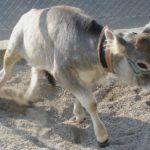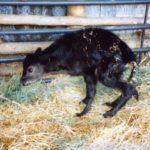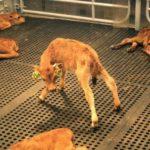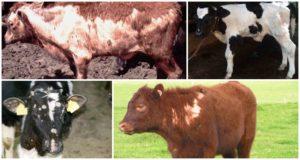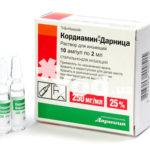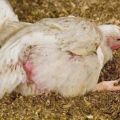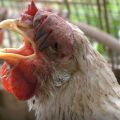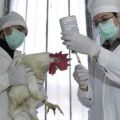Signs of white muscle disease in calves and home treatment
The development of white muscle disease in calves is often observed in the first weeks of life. This pathology is characterized by a violation of metabolic processes and problems with the performance of contractile functions. The danger of muscular dystrophy is that it cannot be eliminated. After an illness, the calf will not develop well. If treatment is not started on time, the mortality rate reaches 60%. Therefore, the very first symptoms of the disease require the help of a veterinarian.
What are the features of pathology
Bovine bone disease is an endemic pathology. It affects mainly young animals. Currently, the disease is not well understood. Usually the pathology affects calves. However, sometimes it also occurs in other representatives of cattle.
If the use of conventional drugs does not give positive results within 3-5 days, it is recommended to urgently start using antibacterial drugs. As a result of the pathology, the heart muscle suffers, the skeletal muscles are deformed, and morphological processes are observed in the structure of internal organs.
With the development of pathology in a sick animal, a decrease in the level of total protein and an increase in nitrogen are observed. A distinctive feature of the pathology is considered to be a violation of creatinine metabolism and an increased content of phosphorus. Pathology is more common in New Zealand, USA, Australia.
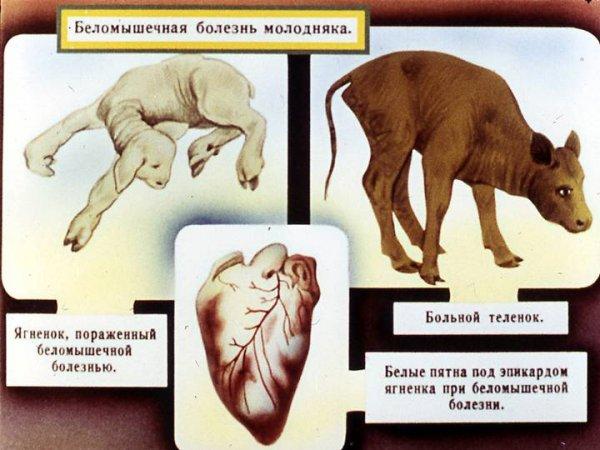
Symptoms of the disease
Pathology is distinguished by several developmental options, each of which has specific symptoms. The duration of the acute stage is 7-10 days. The following signs are characteristic of pathology:
- general oppression;
- development of tachycardia;
- heart weakness;
- increased breathing;
- the appearance of symptoms of conjunctivitis, which are accompanied by blurred eyes;
- severe nasal discharge;
- violations of the alimentary tract;
- bloating;
- profuse salivation;
- paralysis and paresis - while the calf has a violation of motor activity;
- gnashing of teeth.
Other forms of the disease are characterized by less severe symptoms. At the same time, an accurate diagnosis can only be made by a veterinarian.
Forms
There are several options for the development of the disease. Each of them has a specific clinical picture.
Sharp
The acute form of the white mouse is characterized by the general weakness of the animals. They suffer from stiffness of movement. Calves often have tremors and cramps. After a while, other signs appear. These include paralysis of the limbs or other parts of the body. Paresis may also occur. With this course of the disease, there is a clear disruption of the work of the heart and blood vessels. This condition is characterized by an increase in heart rate, which reaches 140-180 beats per minute. In this case, weak and dull heart sounds occur.
Subacute
This form is characterized by less severe symptoms. The main signs of the disease include a noticeable deterioration in appetite, the appearance of wheezing in the sternum, a slight depression of the animal.
With the development of a subacute form of pathology, a sharp decrease in the parameters of the body's stability is observed.
As a result, he becomes more vulnerable to various pathologies. This leads to inflammation and pleurisy in the calf. This form of pathology is present for 14-30 days. Moreover, in 60% of cases, it provokes the death of the calf.

Chronic
The chronic course of the disease is characterized by a clear depletion of the body of cattle and a slowdown in its development. In this case, symptoms of heart failure occur, and the development of anemia is observed. Subacute and chronic forms of pathology in calves can cause dangerous health consequences - gastroenteritis and bronchopneumonia.
Diagnostic rules
If white muscle disease is suspected, it is important to engage in a comprehensive diagnosis of animal myopathy. It is important to take into account the clinical picture and research results. It is also worth comparing the analysis data with the age category of the animal in order to exclude the development of pathologies with a similar clinical picture.
Performing fluoroscopy is also important. Electrocardiography is recommended to assess the functioning of the heart. This procedure helps detect damage to the heart muscle. If the calf died, pathological changes help to identify myopathy. These include the following:
- severe damage to skeletal muscles;
- an increase in the size of the heart and lungs;
- swelling in the layers of fiber;
- softening of the brain.
Differential diagnosis is of no small importance. In this case, it is necessary to distinguish pathology from enzootic ataxia.
How to cure cattle ailment
To cope with the disease at home, you must strictly adhere to the recommendations of the veterinarian and maintain the normal condition of the animal. Once an accurate diagnosis has been made, the sick calf should be isolated immediately. He definitely needs a warm bedding. It will protect the animal from hypothermia and other pathologies.
Adherence to a special diet is also important. It consists in the introduction of such products into the diet:
- carrot;
- quality hay;
- bran;
- fresh dairy products.
It is very important to maintain a healthy drinking regime. In addition, it is important to control the cleanliness in the box and systematically clean it of food and manure residues.
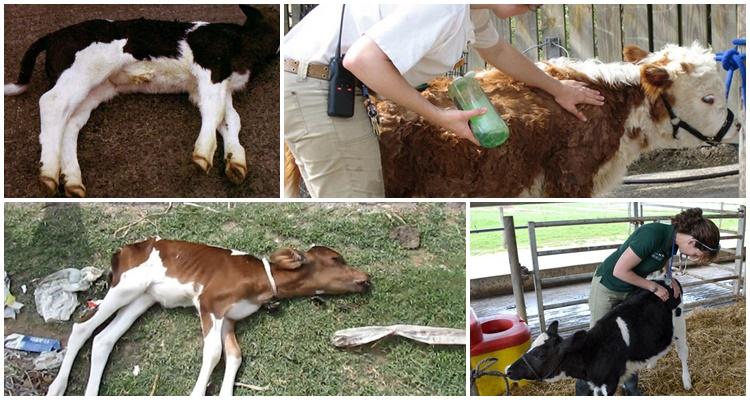
At the same time, specialized medicines that help to cope with pathology are absent today. For treatment, it is worth using the following:
- Sodium Selenite Solution - This helps to replenish the selenium deficiency in the animal's body. The agent is recommended to be administered subcutaneously.
- "Methionine" - this amino acid allows you to restore disturbed metabolic processes.
- "Tocopherol" - ensures the normalization of metabolic processes.
- "Cysteine".
The dosage of medicines is determined by the veterinarian - this is done taking into account the stage of the disease.
Folk remedies
Pathology is usually not treated with folk remedies. Camphor oil can be used as an adjunct to the usual course of therapy. It is also acceptable to use "Cordiamin". These substances improve the functioning of the heart muscle.
Prevention of white muscle disease
After recovery, the calves have difficulty growing and have many problems. Therefore, the main method of combating the disease is not therapy, but prevention. Even with a lack of selenium, a healthy calf may not get sick. Therefore, proper nutrition of the female at the end of pregnancy is of particular importance.
During this period, it is recommended to adhere to a two-phase feeding with low nutritional value in dead wood 3-8 weeks before the planned calving. At the same time, in recent days, it needs to be gradually increased.
The recommended concentrations of calcium and phosphorus, as well as their ratio, also differ. In recent weeks, preventive measures are required that are aimed at preventing ketosis. This violation provokes the birth of weakened calves. To avoid problems, it is recommended to saturate the diet of cattle with energy supplements. These include "Felutsen" and "Propylene glycol".
The high content of vitamins is of great importance - first of all, fat-soluble ones. Lack of carotene increases the need for antioxidants. Therefore, it is worth performing prophylactic administrations of "E-selenium". This tool is used by injection.
A couple of months before the birth of the calf, the cow is recommended to inject the agent intramuscularly or subcutaneously. Usually, 15 milliliters of substance are used per 1 individual. In this case, it is required to perform 3-4 injections with an interval of 2 weeks. White muscle disease is a serious condition that can be fatal in the calf. To avoid this and prevent growth retardation, it is necessary to consult a veterinarian in a timely manner and strictly follow his recommendations. However, it is much better to engage in the prevention of the development of pathology.
